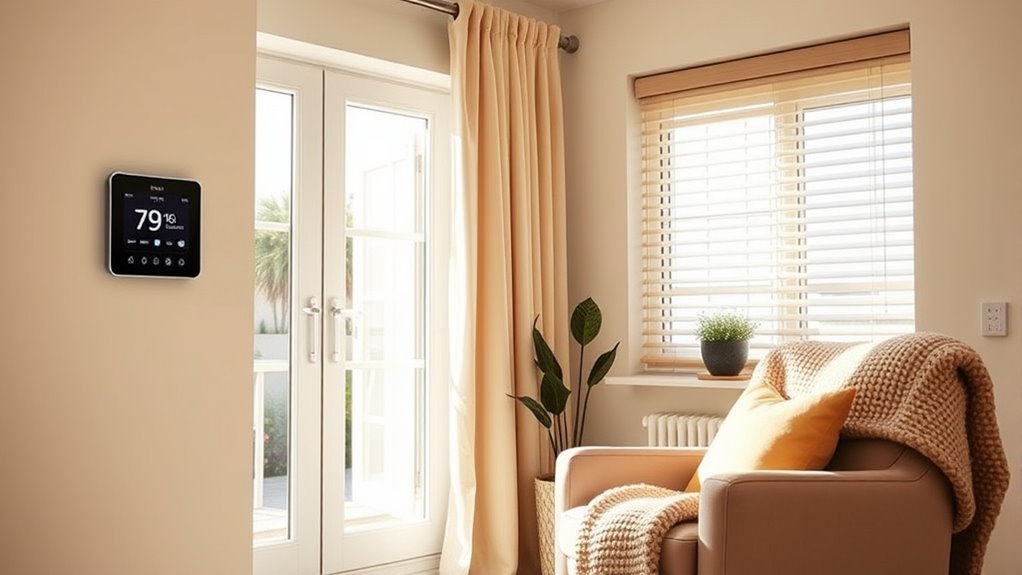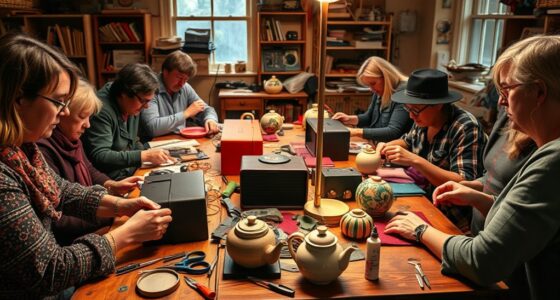To save energy passively at home, maximize natural light by opening curtains and keeping windows clean. Use curtains and blinds strategically to trap heat or block out warmth when needed. Insulate walls, floors, and pipes, seal cracks and gaps, and upgrade windows for better insulation. Adjust your heating and cooling to avoid excess energy use and embrace passive ventilation by opening windows during cooler times. Keep exploring for more simple ways to enhance your home’s energy efficiency.
Key Takeaways
- Maximize natural light by opening curtains and keeping windows clean to reduce reliance on artificial lighting.
- Use curtains, blinds, and weatherstripping to regulate indoor temperatures and prevent heat loss.
- Insulate walls, attics, and floors to enhance thermal efficiency and minimize heat transfer.
- Adjust thermostats seasonally and employ zoning to optimize heating and cooling with minimal energy use.
- Regularly maintain and upgrade windows and sealing materials to improve insulation and prevent drafts.
Maximize Natural Light During the Day
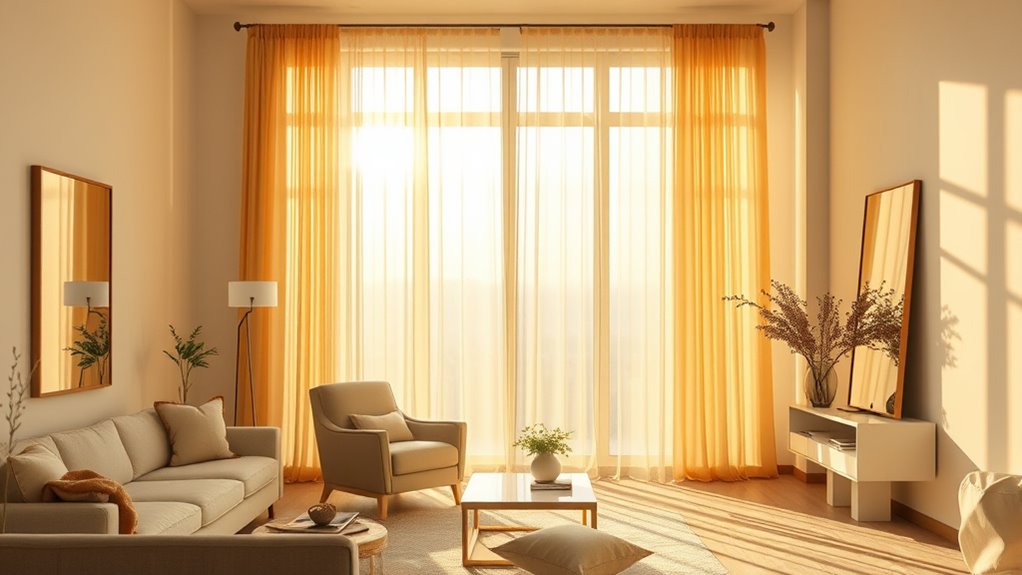
Maximizing natural light during the day is one of the simplest ways to save energy at home. By opening your curtains and blinds early, you let sunlight flood your rooms, reducing the need for artificial lighting. Strategically placing mirrors can also help bounce light deeper into your space, making it feel brighter without extra energy use. Keep windows clean so sunlight can enter freely. Trim back any outdoor foliage that blocks sunlight from reaching your windows. During the day, keep curtains open when sunlight is available, especially in rooms you use most. This not only improves indoor brightness but also warms your home naturally, lowering heating needs. Additionally, using proper window treatments can enhance natural light penetration and help maintain consistent indoor temperatures. Being mindful of building design can also optimize sunlight exposure and further reduce energy consumption. Incorporating energy-efficient windows can significantly improve natural lighting and insulation, leading to additional savings. Small adjustments like these, along with window placement, make a significant impact on your overall energy consumption and can be part of a broader sustainable living approach.
Use Curtains and Blinds Effectively

Using curtains and blinds effectively can substantially reduce your home’s energy consumption. During winter, keep curtains closed at night to trap heat and stay warm. In summer, open blinds during the day to let sunlight warm your space naturally, then close them in the evening to block out heat. Adjusting your window coverings based on the time of day helps maintain a comfortable indoor temperature and reduces reliance on heating or cooling systems. To guide your choices, consider this table:
| Time of Day | Coverings | Purpose |
|---|---|---|
| Morning | Open blinds | Maximize sunlight heating |
| Afternoon | Close curtains | Keep heat out in summer |
| Evening | Close curtains | Insulate and retain heat |
| Night | Close curtains | Prevent heat loss |
| Daylight | Adjust as needed | Balance light and heat |
Implementing passive energy‑saving habits like these can make a noticeable difference in your home’s efficiency. Incorporating energy-efficient window coverings can further enhance these efforts and optimize your home’s temperature control. Additionally, choosing curtains made from thermal insulating fabrics can improve heat retention during colder months. Selecting high-quality window coverings can also contribute to better energy conservation and overall comfort, especially when combined with proper installation techniques.
Insulate Your Home Properly
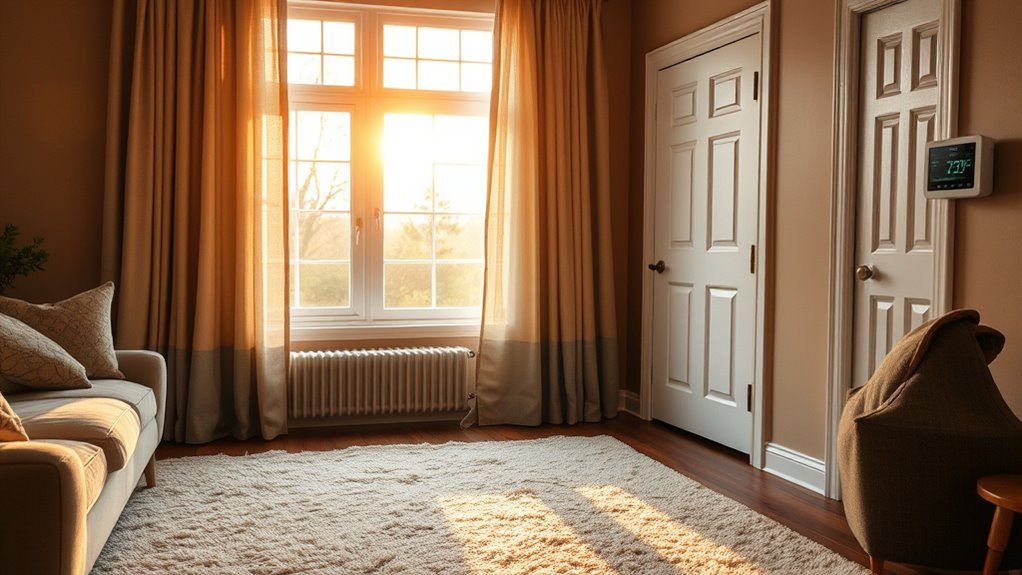
Proper insulation is a key step in maintaining a comfortable indoor environment and reducing energy bills. When your home is well-insulated, it keeps heat inside during winter and blocks heat from entering during summer. Start by checking your walls, attic, and floors for gaps or thin areas. Add insulation where needed, using materials like fiberglass, foam, or cellulose. Don’t forget to insulate pipes and ducts to prevent heat loss. Proper insulation also reduces the workload on your heating and cooling systems, saving energy and money. Regularly inspect and top up insulation as it settles or degrades over time. Additionally, ventilation practices can help maintain indoor air quality and further improve energy efficiency. Using the appropriate self watering plant pots can also contribute to energy savings by reducing indoor humidity and maintaining optimal plant health. Incorporating energy-efficient appliances can further enhance your home’s overall energy savings. Before installing new appliances, consider having them undergo Portable Appliance Testing (PAT) to ensure safety and compatibility with your home’s electrical system. By insulating your home correctly, you create a more energy-efficient space that stays cozy and cool without extra effort or expense. Implementing automation technologies can help monitor and optimize your heating and cooling systems for even greater efficiency.
Seal Drafts and Gaps
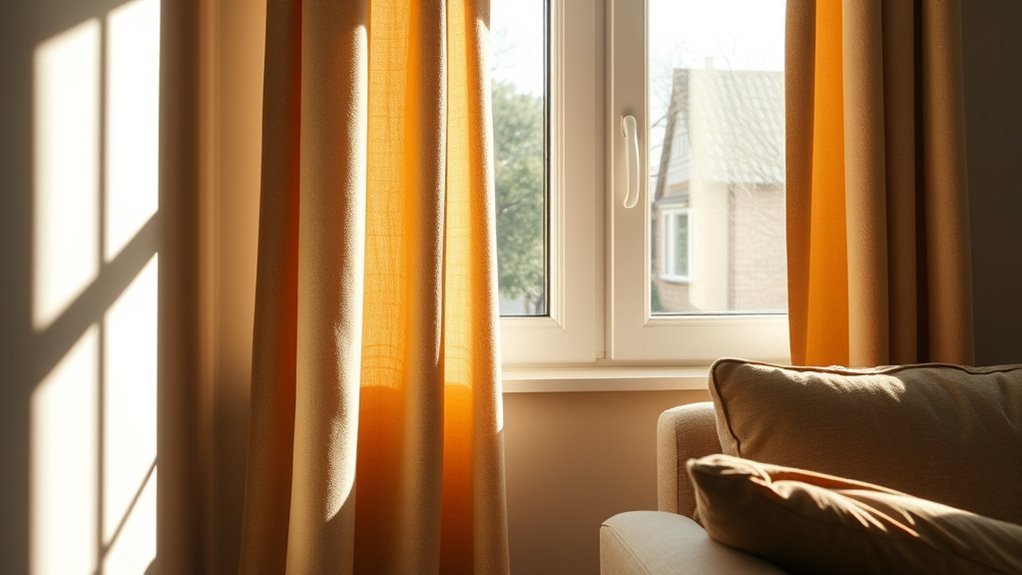
You can start saving energy by spotting common leak areas like windows, doors, and vents. Once you identify these gaps, use effective sealing materials such as weatherstripping or caulk to block drafts. Sealing leaks now makes a noticeable difference in maintaining a comfortable, energy-efficient home. Additionally, understanding passive energy-saving habits can help optimize your home’s efficiency over time. Incorporating insulation techniques further enhances the home’s ability to retain heat and reduce energy consumption. Being aware of core personality traits can also add a personalized touch when caring for your pets in a comfortable home environment. For example, using weatherstripping for existing gaps can improve your home’s energy retention beyond just sealing leaks.
Identify Common Leak Areas
Have you ever felt a chilly breeze or noticed an increase in your heating bill without understanding why? The culprit might be hidden leaks around your home. Start by inspecting windows and doors—look for gaps or cracks where air can sneak through. Feel for drafts near electrical outlets, baseboards, and ceiling fixtures. Don’t forget to check attic hatches, vent covers, and the space around pipes or chimneys. Use a lit candle or incense stick to detect airflow—if the smoke flickers or moves, you’ve found a leak. Also, scan your walls and floors for cracks or unsealed seams. Identifying these leak areas is the first step to making your home more energy-efficient and comfortable. Once found, you can seal these gaps to keep warm air in and cold air out. Properly sealing these energy leak areas can significantly reduce your energy consumption and improve overall home comfort. Additionally, understanding and addressing cookie consent can help you maintain a secure browsing environment while managing your online privacy.
Use Effective Sealing Materials
Once you’ve identified the leaks around your home, the next step is to seal them effectively. Use high-quality sealing materials like weatherstripping, caulk, or foam tape designed for specific gaps. For gaps around windows and doors, apply weatherstripping or door sweeps to block drafts. Seal cracks and holes with exterior-grade caulk, ensuring a tight seal that prevents air leaks. For larger gaps, foam sealant provides a durable barrier. Remember to clean surfaces thoroughly before applying any sealant to ensure adhesion. Regularly inspect and replace worn-out or damaged materials to maintain energy efficiency. Proper sealing not only keeps your home warmer in winter and cooler in summer but also reduces your energy bills and environmental impact.
Optimize Heating and Cooling Usage
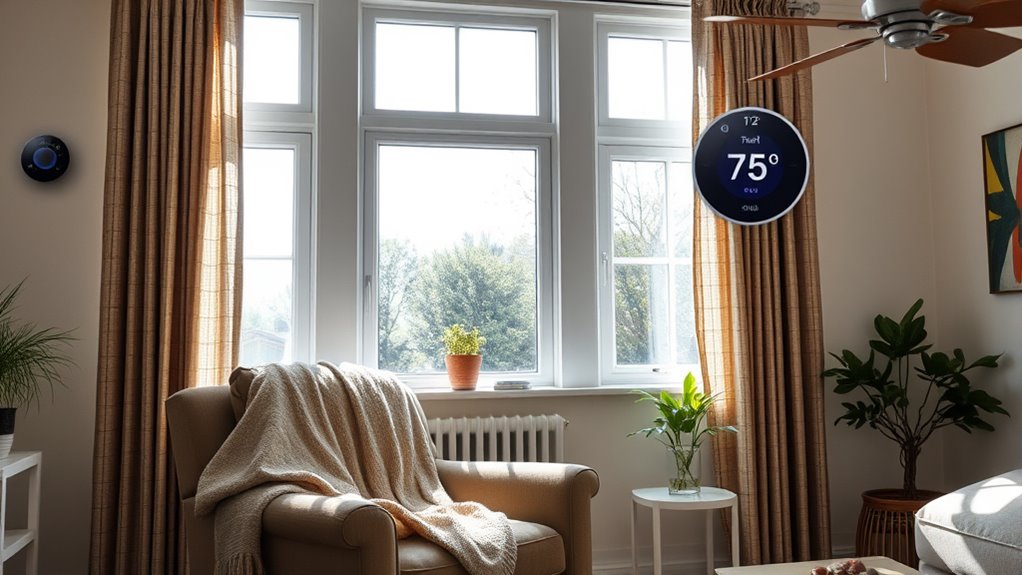
To save energy on heating and cooling, start by adjusting your thermostat to comfortable but efficient levels. Using programmable devices allows you to set your system to run only when needed, while zoning strategies help target specific areas for better control. These simple steps can substantially reduce your energy bills and improve your home’s efficiency.
Adjust Thermostat Settings
Adjusting your thermostat settings can substantially reduce energy consumption without sacrificing comfort. Small changes make a big difference: lowering or raising the temperature by a few degrees during the day and at night can cut costs. Consider these tips:
- Set your thermostat to 68°F (20°C) in winter when you’re home and awake.
- Reduce the temperature by 7-10°F (4-5°C) when you’re away or asleep.
- Use fans to help circulate air, allowing you to set the thermostat even lower in winter or higher in summer.
Use Programmable Devices
Using programmable thermostats allows you to automatically adjust your home’s temperature based on your schedule, ensuring energy isn’t wasted when you’re away or asleep. By setting your thermostat to lower the heat or cooling during unoccupied hours, you reduce unnecessary energy consumption without sacrificing comfort. This device enables you to create customized heating and cooling schedules, so your home stays comfortable when you’re present and conserves energy when you’re not. You can program different temperatures for weekdays and weekends, aligning with your routines. Some models even learn your habits over time, optimizing settings further. Using these devices helps you save money on energy bills and reduces your carbon footprint. With minimal effort, you can take control of your home’s energy use, making your habits smarter and more passive.
Implement Zoning Strategies
Implementing zoning strategies allows you to target specific areas of your home for heating and cooling, which can substantially boost energy efficiency. By dividing your home into zones, you can focus on where comfort is needed most, reducing unnecessary energy use. Use programmable thermostats to automate adjustments, ensuring spaces are heated or cooled only when occupied. Seal off unused areas with dampers or curtains to prevent heat loss or gain. This approach not only saves energy but also extends the lifespan of your HVAC system.
- Focus on active management of individual zones to maximize savings
- Regularly inspect and maintain dampers and thermostats for ideal performance
- Tailor temperature settings to different zones based on usage patterns
Embrace Passive Ventilation Techniques
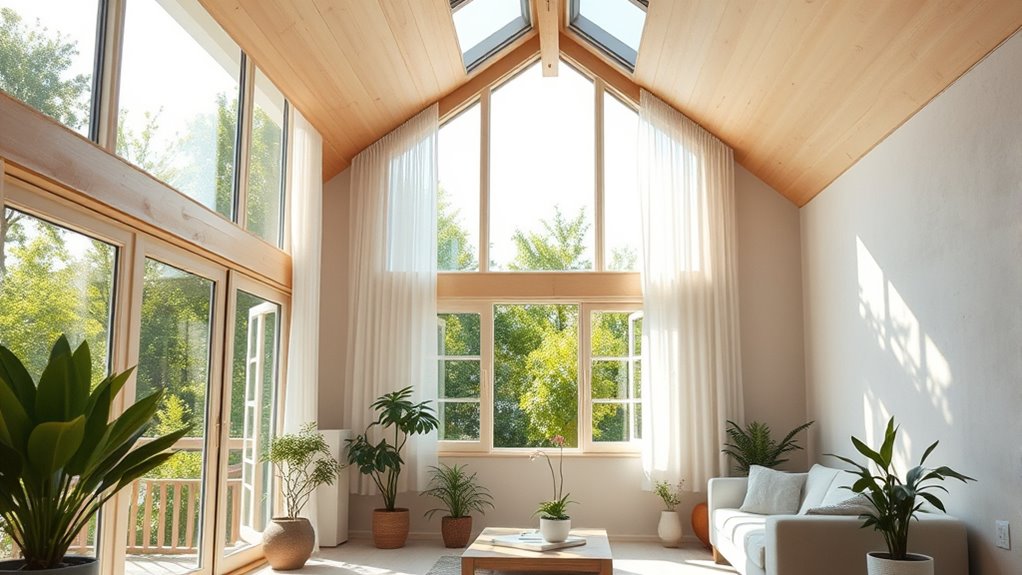
Passive ventilation techniques can substantially reduce your energy bills by naturally cooling and invigorating your home. You can achieve this by opening windows strategically to create cross-ventilation, allowing fresh air to flow through your space. Use vents, vents, and trickle vents to facilitate airflow even when windows are closed, especially during cooler evenings and mornings. Position your furniture to avoid blocking air pathways, ensuring smooth circulation. Consider installing vents near the roof and basement to promote vertical airflow, which helps remove stale air and brings in fresh air. Keep in mind, timing is key—ventilate during cooler parts of the day and close windows during hot afternoons to prevent heat gain. Embracing passive ventilation is an easy, effective way to lower energy costs while keeping your home fresh.
Maintain and Upgrade Windows for Efficiency
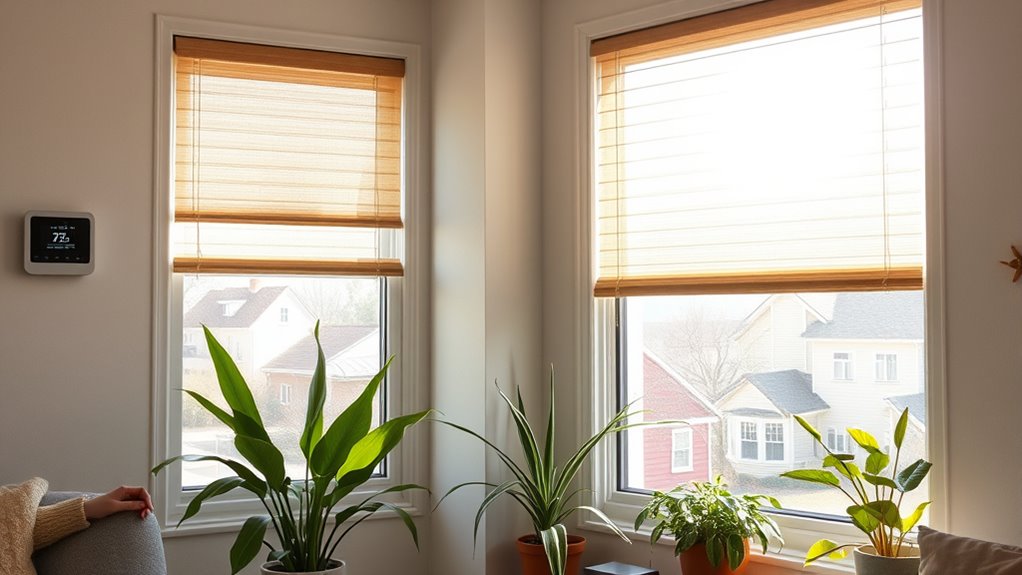
Regularly inspecting and maintaining your windows can considerably improve your home’s energy efficiency. Check for gaps, leaks, and damaged seals that let air in or escape. Clean your windows frequently to maximize natural light and reduce the need for artificial lighting. Upgrading to double or triple-glazed windows can greatly improve insulation, keeping your home warmer in winter and cooler in summer. When upgrading, consider the following:
- Choose energy-efficient window frames and glazing
- Seal gaps with weatherstripping or caulking
- Use window films or curtains to enhance insulation
These steps help prevent heat transfer, reduce energy bills, and create a more comfortable living space. Proper maintenance and upgrades are essential for passive energy savings at home.
Frequently Asked Questions
How Can I Identify Hidden Heat Leaks in My Home?
To find hidden heat leaks in your home, start by inspecting common trouble spots like windows, doors, and electrical outlets. Feel for drafts by holding a candle or incense near these areas—if the flame flickers, you have a leak. Check for gaps around pipes and vents, and use weatherstripping or caulk to seal them. Conduct a thorough visual inspection, and consider a professional energy audit for a detailed assessment.
What Are the Best Eco-Friendly Insulation Options?
Imagine you’re back in the 1800s, but today, you can choose eco-friendly insulation options. You should opt for materials like sheep’s wool, cellulose made from recycled paper, or cork, which are sustainable and effective. These options reduce your carbon footprint and keep your home warm. They’re better for the environment than traditional fiberglass or foam. So, pick wisely to stay cozy and eco-conscious at the same time.
How Often Should I Service My Heating and Cooling Systems?
You should service your heating and cooling systems at least once a year, ideally before peak usage seasons. Regular maintenance guarantees your systems run efficiently, saving energy and reducing costs. Check filters monthly and replace or clean them as needed. If you notice unusual noises, reduced airflow, or increased energy bills, schedule a professional service sooner. Staying proactive helps extend your system’s lifespan and keeps your home comfortable year-round.
Can Plants Help Improve Passive Energy Savings Indoors?
Plants can definitely help improve passive energy savings indoors. They act as natural insulators, reducing heat loss during winter and keeping spaces cooler in summer. Plus, plants improve humidity and air quality, making your home more comfortable overall. By strategically placing plants near windows or vents, you can enhance your home’s energy efficiency. So, adding greenery isn’t just aesthetic — it actively supports your passive energy-saving efforts inside.
What Are Cost-Effective Ways to Upgrade Old Windows?
When it comes to upgrading old windows, you’re really killing two birds with one stone. First, add weatherstripping or caulk around frames to seal leaks cheaply. Consider window film or shrink wrap kits for an easy, cost-effective insulation boost. If you’re handy, installing acrylic panes or storm windows helps improve energy efficiency without breaking the bank. These simple steps keep drafts out and your heating or cooling costs down.
Conclusion
By adopting these passive energy-saving habits, you’ll make your home more efficient and comfortable. Think of your house as a well-tuned orchestra—every element working seamlessly together to save energy. I once improved my insulation and noticed my heating bills dropped by 20%. Small changes, like sealing drafts or maximizing natural light, can have a big impact. Remember, a little effort now creates a warmer, greener home for years to come.
